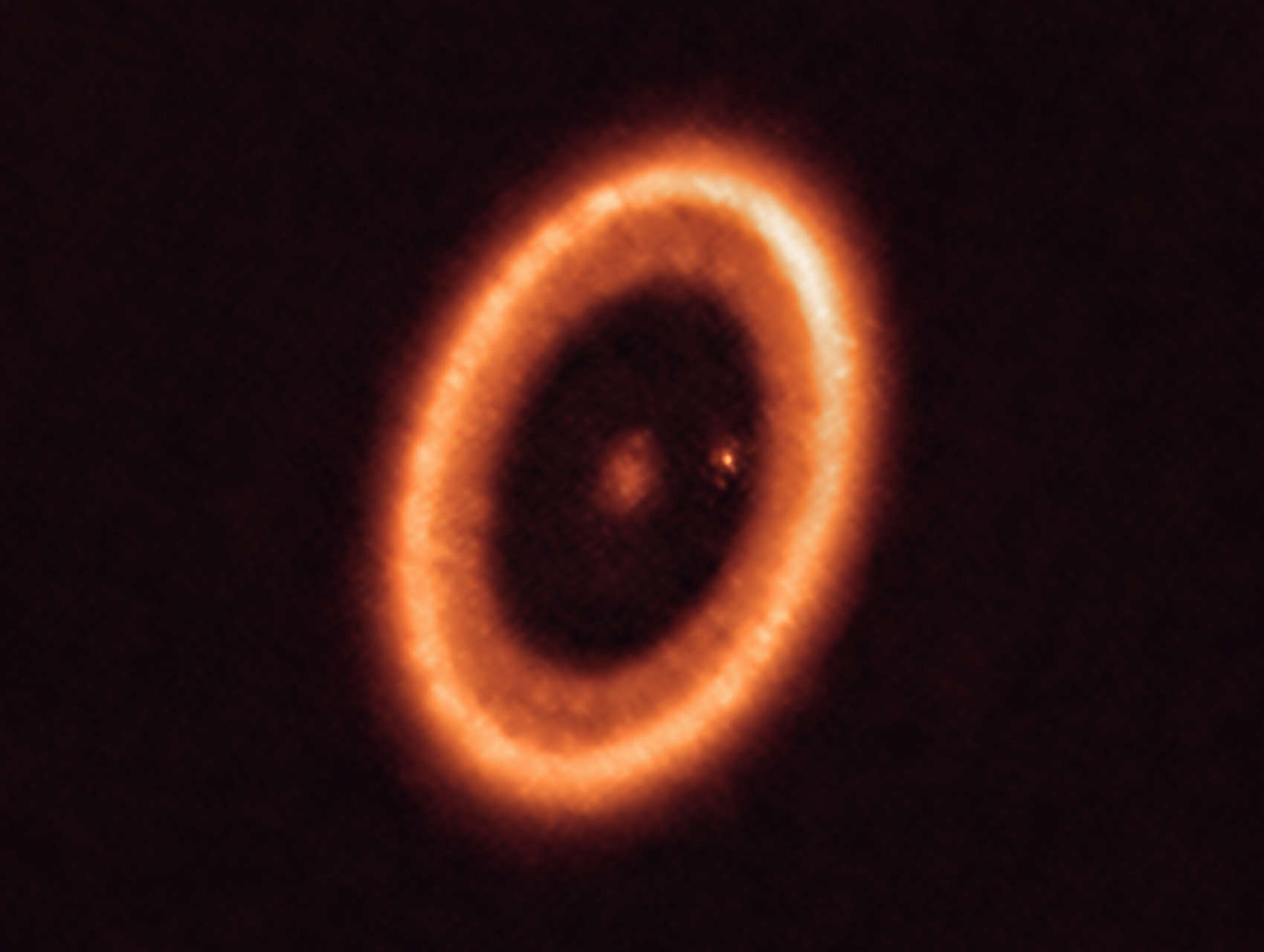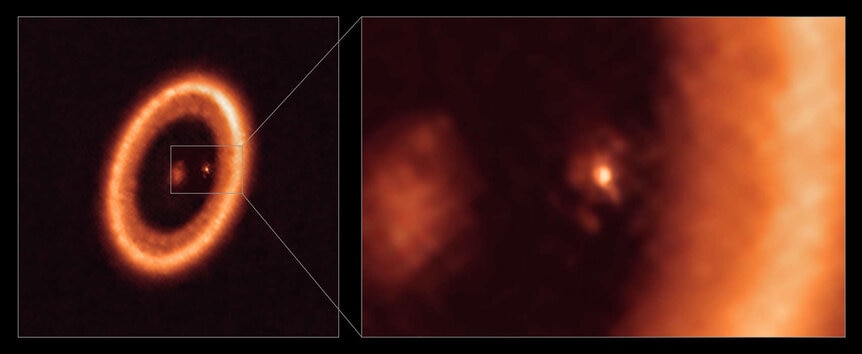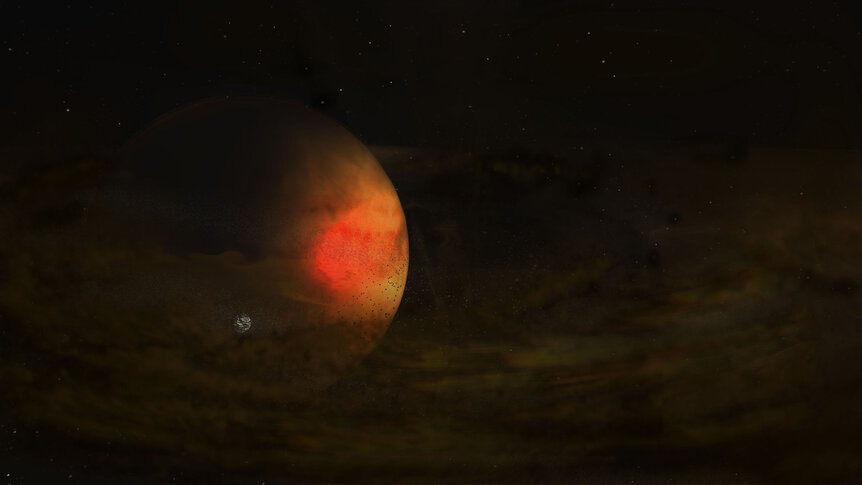Create a free profile to get unlimited access to exclusive videos, sweepstakes, and more!
A disk of material around an alien planet may be forming moons as we watch

So far, astronomers have found nearly 4,500 exoplanets orbiting other stars. But, despite that large number, there has been no solid detection of an exomoon, a moon orbiting any of those planets* .
However, there’s intriguing evidence that a planet orbiting a nearby star may have the raw materials to build a moon, and one or more moons may be forming there right now. New (and extremely cool) observations confirm earlier ones that the planet is surrounded by a disk of dust with enough mass to make several moons the size of our own Moon.
The star is called PDS 70. It’s about 365 light years away, and very young, roughly 5 million years old (for comparison the Sun is 4.6 billion, a thousand times older). It’s so young it’s still surrounded by a circular disk of gas and dust that is clearly seen in high-resolution images. It’s actually more of a ring, a disk with a huge cavity in the middle. The inner edge of the ring is about 6.8 billion kilometers from the star, and extends out to about 15 billion (we see it at an angle so it looks like an ellipse).
Between the star and the ring are two known planets, called PDS 70b and c. It’s not known how big they are, but it’s very likely both are somewhere between 1 and 10 times the mass of Jupiter. The outer one, PDS 70c, is very close to the inner edge of the ring, and it’s likely the gravity of the planet truncates the inner edge of the ring, drawing in gas and dust that gets any closer to the star. Both planets together have gravitationally swept clean a large region around the star out to the ring.
In 2019, though, a team of astronomers using ALMA (the Atacama Large Millimeter/submillimeter Array) reported finding an excess of long wavelength light coming from PDS 70c. At this wavelength (855 microns or 0.855 mm, if you’re taking notes) the planet should be very faint, so this must be coming from something else. They concluded it may be a circumplanetary disk, a disk of dust around the planet itself, which can glow at this wavelength.
New observations clinch it, though. They have higher resolution, and can cleanly separate the planet from the inner edge of the outer ring, pretty convincingly showing that the excess light is coming from the area around the planet. The circumplanetary disk isn’t resolved (that is, it appears a dot to the telescope), which means it must be less than about 360 million kilometers in diameter, a fraction bigger than Earth’s orbit around the Sun. Given how bright it is, they estimate it’s likely no smaller than about 180 million km across, too.
The dust in the disk is cold, about -245° C (-410° F) — mind you, this planet is about as far from its star as Neptune is from the Sun. Mighty chilly in those parts. Given its temperature and likely dust grain size, the astronomers estimate the disk mass to be about 0.007 – 0.031 times the mass of the Earth. That’s roughly ½ to 2.5 times the mass of our Moon, so possibly enough to make a decent-sized satellite. I’ll note that this is the mass now; it’s possible a moon or moons has/have been forming in there already, so this is the mass left over from an ongoing moon formation process.
That’s so cool! We may be witnessing the formation of a Jupiter-like moon system with PDS 70c. Amazing.
The other planet, PDS 70b, also has too much 855 micron emission, so it too may have a circumplanetary disk. It’s closer to the star, so the disk must be smaller (the star’s gravity will truncate its size; if it gets too big the dust will be pulled away from the planet). Is it forming moons as well? Maybe.
Earlier I said the planets have swept a large region of the system clean of dust. However, the ALMA observations also show there’s an inner ring of dust which extends no further than about 2.5 billion km from the star. This ring is faint and therefore not terribly massive; the authors estimate it has a mass no more than about 1/3rd the Earths, and possibly less. It might be making a smaller planet orbiting closer in, but given how thinly spread the dust is that seems unlikely. On the other hand, if there are planets that close to the star they’d be nearly impossible to spot.
On top of all that, they see the outer ring has a bright region in it where dust may be piling up. That could indicate yet another planet orbiting near the ring, too faint to detect in the images. The sharp outer edge of the ring also implies something out there cutting it off. It’s not conclusive, but clearly this system is packing a lot of surprises. I expect astronomers will be observing it a lot over the coming years.
I wonder if this is what our own solar system looked like 4.55 billion years ago, when the planets were just starting to coalesce? I do enjoy the scientific aspects of PDS 70, what we can learn about stellar and planetary formation from it. But it’s hard not to take it personally, and wonder if it’s like seeing our own baby pictures, if any had been taken eons ago.
*There’s compelling evidence that the Jupiter-sized world Kepler-1625b may have a Neptune-sized moon, but it has not yet been confirmed.





























